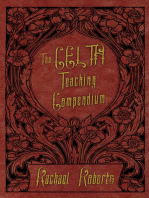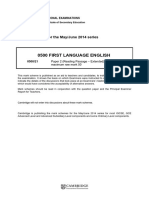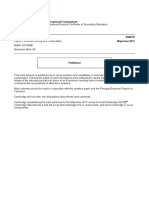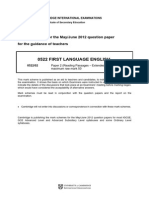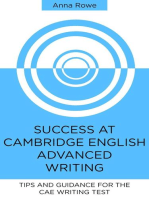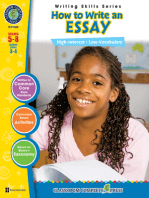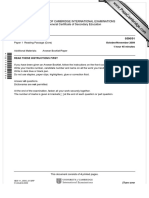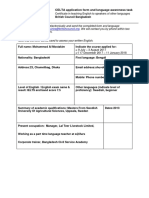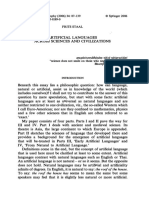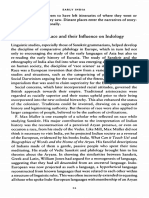0500 s16 Ms 22 PDF
0500 s16 Ms 22 PDF
Uploaded by
Rana SidCopyright:
Available Formats
0500 s16 Ms 22 PDF
0500 s16 Ms 22 PDF
Uploaded by
Rana SidOriginal Title
Copyright
Available Formats
Share this document
Did you find this document useful?
Is this content inappropriate?
Copyright:
Available Formats
0500 s16 Ms 22 PDF
0500 s16 Ms 22 PDF
Uploaded by
Rana SidCopyright:
Available Formats
Cambridge International Examinations
Cambridge International General Certificate of Secondary Education
FIRST LANGUAGE ENGLISH 0500/22
Paper 2 Reading Passages – Extended May/June 2016
MARK SCHEME
Maximum Mark: 50
Published
This mark scheme is published as an aid to teachers and candidates, to indicate the requirements of the
examination. It shows the basis on which Examiners were instructed to award marks. It does not indicate the
details of the discussions that took place at an Examiners’ meeting before marking began, which would have
considered the acceptability of alternative answers.
Mark schemes should be read in conjunction with the question paper and the Principal Examiner Report for
Teachers.
Cambridge will not enter into discussions about these mark schemes.
Cambridge is publishing the mark schemes for the May/June 2016 series for most Cambridge IGCSE®,
Cambridge International A and AS Level components and some Cambridge O Level components.
® IGCSE is the registered trademark of Cambridge International Examinations.
This document consists of 10 printed pages.
© UCLES 2016 [Turn over
Page 2 Mark Scheme Syllabus Paper
Cambridge IGCSE – May/June 2016 0500 22
Question 1
This question tests reading assessment objectives R1 to R3 (15 marks)
R1 demonstrate understanding of explicit meanings
R2 demonstrate understanding of implicit meanings and attitudes
R3 analyse, evaluate and develop facts, ideas and opinions
and writing assessment objectives W1 to W4 (5 marks)
W1 articulate experience and express what is thought, felt and imagined
W2 sequence facts, ideas and opinions
W3 use a range of appropriate vocabulary
W4 use register appropriate to audience and context
You are Miss Salmon. On the evening of the false alarm you write a letter to a friend.
Write the letter.
In your letter you should:
• comment on the events of the day, what exactly happened and how you feel now
• explain why you behaved as you did
• suggest your possible courses of action now and what their consequences might be.
Base your letter on what you have read in Passage A, but be careful to use your own words.
Address each of the three bullet points.
Begin your letter, ‘Dear friend,
Something happened today that I need to tell someone about…’
Write about 250 to 350 words.
Up to 15 marks are available for the content of your answer, and up to 5 marks for the quality
of your writing. [20]
General notes
Candidates should select ideas from the passage (see page 6) and develop them relevantly,
supporting what they write with details from the passage. Look for an appropriate register for the
genre, and a clear and balanced response which covers the three areas of the question, is well
sequenced, and is in the candidate’s own words.
Annotate A1 for references to the events of the day and her feelings now
Annotate A2 for references to the reasons for her behaviour
Annotate A3 for references to possible courses of action now and what their consequences might be.
© Cambridge International Examinations 2016
Page 3 Mark Scheme Syllabus Paper
Cambridge IGCSE – May/June 2016 0500 22
Responses might use the following ideas:
A1: Comment on the events of the day, what exactly happened and how you feel now
• timetable disrupted / lesson(s) missed (det. afternoon) [dev. relieved, feeling calmer]
• governor visit / important meeting (det. Mrs. Basu, inspecting standards, disrupted) [dev. affect
report]
• passing Headmaster’s office (det. sneaking) [dev. had to be very quiet , fortunate not to have
been caught]
• personal secretary fetching registers (det. Mrs Edmondson returning to building) [dev. not
really risking life]
• fire alarm was set off / broke the glass (det. hoax, expensive, toffee hammer) [dev.
irresponsible, feeling guilty]
• assembled whole school (det. playing fields, continuous ring ) [dev. waste of time]
• lectured by the Headmaster (det. despicable deed, sniggers, threatens consequences [dev.
ineffective, melodramatic, harsh]
A2: Why you behaved as you did
• terrified (det. not to impress) [dev. did not want her failure being witnessed ]
• under attack (det. pack, tall boy) [dev. unable to control class, bullying]
• lack of respect from class (det. no one listens) [dev. (not a) good Geography teacher]
• high academic standards (det. Olympian, awkward questions) [dev. pressure, feels inadequate
/ unfairly judged]
• does not fit in / unsure what is expected of her (det. rules of the game, carrier bag / rented
room) [dev. compared to the grandeur of school]
• no one to turn to for help or advice (det. friends, confidante) [dev. lonely, isolated]
• workload (det. unfinished marking ) [dev. not coping with pressure]
• could not face the lesson (det. Geography ) [dev. snapped / desperate ]
A3: Suggest your possible courses of action now and what their consequences might be
• confess / tell Headmaster
• keep quiet / hope it passes dev nobody would suspect teacher
• blame a student / student gets the blame [dev. unethical]
• resign / leave voluntarily / choose to stay [dev. have to leave teaching all together+]
• reputation affected [dev. couldn’t get another job]
• change approach / get help (det. mentor) [dev. try to improve lessons/control ]
• challenge the head’s behaviour [dev. tell him just what she thinks of him]
• apologise (det. each and every one in turn) [dev. humiliation]
• forced to leave / might be sacked / suspended [ dev. financial consequences]
The discriminator is the development of the main character’s feelings and experiences, as this
requires candidates to draw inferences. Ideas and opinions must be derived from the passage,
developing the implications.
© Cambridge International Examinations 2016
Page 4 Mark Scheme Syllabus Paper
Cambridge IGCSE – May/June 2016 0500 22
Marking Criteria for Question 1
Table A, Reading:
Use the following table to give a mark out of 15 for Reading.
Band 1: The response reveals a thorough reading of the passage. Developed ideas are
13–15 sustained and well related to the passage. A wide range of ideas is applied. There is
supporting detail throughout, which is well integrated into the response, contributing
to a strong sense of purpose and approach. All three bullets are well covered. A
consistent and convincing voice is used.
Band 2: The response demonstrates a competent reading of the passage. A good range of
10–12 ideas is evident. Some ideas are developed, but the ability to sustain them may not
be consistent. There is frequent, helpful supporting detail, contributing to a clear
sense of purpose. All three bullets are covered. An appropriate voice is used.
Band 3: The passage has been read reasonably well. A range of straightforward ideas is
7–9 offered. Opportunities for development are rarely taken. Supporting detail is present
but there may be some mechanical use of the passage. There is uneven focus on
the bullets. The voice is plain.
Band 4: There is some evidence of general understanding of the main ideas, although the
4–6 response may be thin or in places lack focus on the passage or the question. Some
brief, straightforward reference to the passage is made .There may be some reliance
on lifting from the text. One of the bullets may not be addressed. The voice might be
inappropriate.
Band 5: The response is either very general, with little reference to the passage, or a
1–3 reproduction of sections of the original. Content is either insubstantial or unselective.
There is little realisation of the need to modify material from the passage.
Band 6: 0 There is little or no relevance to the question or to the passage.
Table B, Writing: Structure and order, style of language
Use the following table to give a mark out of 5 for Writing.
Band 1 5 The language of the response sounds convincing and consistently appropriate.
Ideas are firmly expressed in a wide range of effective and/or interesting
language. Structure and sequence are sound throughout.
Band 2 4 Language is mostly fluent and there is clarity of expression. There is a
sufficient range of vocabulary to express ideas with subtlety and precision. The
response is mainly well structured and well sequenced.
Band 3 3 Language is clear but comparatively plain and/or factual, expressing little
opinion. Ideas are rarely extended, but explanations are adequate. Some
sections are quite well sequenced but there may be flaws in structure.
Band 4 2 There may be some awkwardness of expression and some inconsistency of
style. Language is too limited to express shades of meaning. There is
structural weakness and there may be some copying from the passage.
Band 5 1 Expression and structure lack clarity. Language is weak and undeveloped.
There is very little attempt to explain ideas. There may be frequent copying
from the original.
Band 6 0 The response cannot be understood.
© Cambridge International Examinations 2016
Page 5 Mark Scheme Syllabus Paper
Cambridge IGCSE – May/June 2016 0500 22
Question 2
This question tests Reading Objective R4 (10 marks):
R4 demonstrate understanding of how writers achieve effects
Re-read the descriptions of:
(a) the atmosphere and the headmaster’s speech in paragraph 4 beginning ‘A lull in the
storm …’
(b) the school and the students in paragraph 5, beginning ‘Miss Salmon thought it
unlikely …’.
Select four powerful words or phrases from each paragraph. Your choices should include
imagery. Explain how each word or phrase is used effectively in the context.
Write about 200 to 300 words.
Up to 10 marks are available for the content of your answer. [10]
General notes
This question is marked for the ability to select powerful or unusual words and for an understanding of
ways in which the language is effective. Expect responses to provide words (listed in the mark
scheme on page 9) that carry connotations additional to general meaning.
Mark holistically for the overall quality of the response, not for the number of words chosen, bearing in
mind that there should be a range of choices to demonstrate an understanding of how language
works for the higher bands, and that this should include the ability to explain images. It is the quality of
the analysis that attracts marks. Do not take marks off for inaccurate statements; simply ignore them.
The following notes are a guide to what good responses might say about the selections. They can
make any sensible comment, but only credit those that are relevant to the correct meanings of the
words in the context and that have some validity. Alternative acceptable explanations should be
credited. Credit comments on effects created by non-vocabulary choices such as grammar/syntax
and punctuation devices. They must be additional to comments on vocabulary.
© Cambridge International Examinations 2016
Page 6 Mark Scheme Syllabus Paper
Cambridge IGCSE – May/June 2016 0500 22
(a) The atmosphere and the headmaster’s speech in paragraph 4
The general effect is of exaggerated, melodramatic reaction on the part of the Headmaster
a lull in the storm (image): temporary pause in speech, a quiet period just before he is
about to begin again, suggests something of the ferocity and power of his rant
the rain cloud burst (image): as if a sudden heavy downpour, the headmaster’s furious
words descend on the audience, sudden violence as if exploding with rage or anger
bellowed: shouted loudly, deep roar associated with a bull – dangerous creature , one you’d
stay out of the way of
turning with lightning speed: fast, linking to weather and storms, overdone, dangerous,
threatening
magnificent monologue: dramatic delivery by one character, splendid performance,
posturing, not intended to be answered
like a discarded sweet wrapper rustled between acts, the giggling fell away (image):
cessation of noise, laughter stops, inappropriate behaviour, extends dramatic situation
perpetrator of this felony: guilty person responsible for crime, as if a grave and serious
crime, exaggerated legal jargon / court terms not used in everyday speech, pompous
wanton criminal act: deliberate action, immoral, illegal and irresponsible, over-reaction
(b) The school and the students in paragraph 5
The general effect is of a false and unattainable sense of perfection – bright, white and
spotless
(major criminals) lurked: hiding in wait, concealed, menacing, sinister
rows of bright young students standing to attention: shining and new, intelligent,
standing to attention, obedient, military drilling/precision to achieve this
the pristine white goals: spotless, clean and fresh, in their original condition as if unused,
unnatural for goals on a school playing field, keeping up appearances
immaculately groomed: perfect, brushed, manicured and combed, precise and unrealistic
standards
shining faces dimmed with assumed innocence (image) brilliance or light being
dimmed/darkened, turning it down as if using a switch, assumed innocence suggests they
are not innocent at all and have taken on that mantle.
practised picture of compliance (image): pretending to obey, but practised, well-trained
or rehearsed rather than authentic
pack (image): close-knit group with a leader, hunting animals, ambush, danger
source of the sniggers: source suggests that is where it all starts, origins and sniggers
suggests half-suppressed scornful mocking
© Cambridge International Examinations 2016
Page 7 Mark Scheme Syllabus Paper
Cambridge IGCSE – May/June 2016 0500 22
Marking Criteria for Question 2
Table A, Reading: Language analysis:
Use the following table to give a mark out of 10 for Reading.
Band 1 9–10 Wide ranging and closely focused discussion of language with some high
quality comments that add associations to words in both parts of the question,
and demonstrate the writer’s reasons for using them. Tackles imagery with
some precision and imagination. There is clear evidence that the candidate
understands how language works.
Band 2 7–8 Explanations are given of appropriately selected words and phrases, and
effects are identified in both parts of the question. Images are recognised as
such and the response goes some way to explaining them. There is some
evidence that the candidate understands how language works.
Band 3 5–6 A satisfactory attempt is made to identify appropriate words and phrases. The
response mostly gives meanings of words and any attempt to suggest and
explain effects is basic, vague or very general. One half of the question may be
better answered than the other.
Band 4 3–4 The response provides a mixture of appropriate choices and words that
communicate less well. The response may correctly identify linguistic or literary
devices but not explain why they are used. Explanations of meaning may be
few, general, slight or only partially effective. They may repeat the language of
the original or do not refer to specific words.
Band 5 1–2 The choice of words is insufficient or rarely relevant. Any comments are
inappropriate and the response is very thin.
Band 6 0 The response does not relate to the question. Inappropriate words and phrases
are chosen or none are selected.
For valid choices of words, tick in the body of the response. For imprecise or incomplete choices or
explanation, use ^. For meaning annotate EXP in the margin and for effect (i.e. responses evoked in
the reader) annotate + in the margin. Indicate overview with O.
© Cambridge International Examinations 2016
Page 8 Mark Scheme Syllabus Paper
Cambridge IGCSE – May/June 2016 0500 22
Question 3
This question tests reading assessment objectives R1, R2 and R5 (15 marks)
R1 demonstrate understanding of explicit meanings
R2 demonstrate understanding of implicit meanings and attitudes
R5 select for specific purposes
and writing assessment objectives W1 to W3 (5 marks)
W1 articulate experience and express what is thought, felt and imagined
W2 sequence facts, ideas and opinions
W3 use a range of appropriate vocabulary
(a) Notes
In Passage B, what advice is given to help with the first year of teaching?
Write your answer using short notes. Write one point per line.
You do not need to use your own words.
Up to 15 marks are available for the content of your answer.
(b) Summary
Now use your notes from Question 3(a) to write a summary of the advice given in
Passage B to help with the first year of teaching.
You must use continuous writing (not note form) and use your own words as far as
possible.
Your summary should include all 15 of your points in Question 3(a) and must be 200 to
250 words.
Up to 5 marks are available for the quality of your answer. [20]
© Cambridge International Examinations 2016
Page 9 Mark Scheme Syllabus Paper
Cambridge IGCSE – May/June 2016 0500 22
Reading content for Question 3(a)
Advice offered to help with the first year of teaching
Give 1 mark for a point up to a maximum of 15 about the need to :
1. be positive / it will get better
2. accept it will be hard at times / accept it will be challenging
3. control your surroundings / set up room properly/ remove distractions
4. arrive early and stay late / work long hours
5. have more material than you need / two hours’ material for every hour of actual teaching /
have twice as much material than you need
6. form positive working relationships / healthy relationships with staff (and
administrators)
7. get parents on side / form positive relationships with parents / parents are allies
8. do not be too lenient or too strict / find the middle ground
9. be fair and keep a sense of humour
10. have a back-up plan / be prepared to move on if necessary / be adaptable
11. learn your curriculum inside out / know your subject (syllabus) well
12. look for ways to improve teaching methods / interest students / take account of students
when planning
13. ask a colleague
14. keep a journal / reflect
15. be realistic about what is possible / do not expect too much of yourself / do not be too hard
on yourself
16. take care of yourself physically
Notes:
• Only one point per numbered bullet in an answer can be credited.
• Additional incorrect information negates.
• Credit responses in 3(a) which convey the essence of the point.
Where a point is awarded, indicate with a tick
Where a point is insufficiently clear, indicate with a ^ Where a point is incorrect, do not
annotate
Where a point is repeated, indicate with REP
Although lifting of words and phrases from the passage is acceptable, candidates should show
evidence of understanding and selection by clearly focusing on the key details.
Over-lengthy lifting (e.g. of whole sections containing a number of points) should not be credited.
Where errors of grammar / spelling seriously affect the accuracy of an idea, the point should not be
awarded.
© Cambridge International Examinations 2016
Page 10 Mark Scheme Syllabus Paper
Cambridge IGCSE – May/June 2016 0500 22
Q3(b) WRITING: CONCISION, FOCUS AND WRITING IN OWN WORDS
Use the following table to give a mark out of 5.
Band 1 5 The response is well focused on the passage and the question. All points are
expressed clearly, concisely and fluently, and in the candidate’s own words
(where appropriate) throughout.
Band 2 4 The summary is mostly focused but may have a redundant introduction or
conclusion. Most points are made clearly and concisely. Own words (where
appropriate) are used consistently.
Band 3 3 There may be occasional loss of focus or clarity. There are some areas of
concision. Own words (where appropriate) are used for most of the summary.
Responses may be list-like or not well sequenced.
Band 4 2 The summary is sometimes focused. It may lack some clarity. It may include
comment, repetition, unnecessarily long explanation or lifted phrases.
Band 5 1 The summary is unfocused or wordy. It may be answered in the wrong form
(e.g. narrative, commentary or as notes) or lack clarity. There may be frequent
lifting of phrases and sentences.
Band 6 0 Excessive lifting; no focus. The response cannot be understood or consists
entirely of the words of the passage.
© Cambridge International Examinations 2016
You might also like
- IELTS Advantage Writing SkillsDocument129 pagesIELTS Advantage Writing SkillsJoann Henry95% (132)
- Business Builder 4 6 PDFDocument91 pagesBusiness Builder 4 6 PDFMengTang50% (8)
- 7 Jamaica End of Year Examination.Document6 pages7 Jamaica End of Year Examination.Odayne Marshall100% (4)
- How to Reach the 9.0 in IELTS Academic ReadingFrom EverandHow to Reach the 9.0 in IELTS Academic ReadingRating: 4 out of 5 stars4/5 (17)
- IELTS Academic Writing: Important Tips & High Scoring Sample AnswersFrom EverandIELTS Academic Writing: Important Tips & High Scoring Sample AnswersRating: 4 out of 5 stars4/5 (25)
- TOEFL Writing: Important Tips & High Scoring Sample Answers! (Written By A TOEFL Teacher)From EverandTOEFL Writing: Important Tips & High Scoring Sample Answers! (Written By A TOEFL Teacher)Rating: 4.5 out of 5 stars4.5/5 (6)
- Lord of the Flies - Literature Kit Gr. 9-12From EverandLord of the Flies - Literature Kit Gr. 9-12Rating: 4 out of 5 stars4/5 (10)
- Specimen Paper 3 Mark Scheme 2015Document8 pagesSpecimen Paper 3 Mark Scheme 2015Mrs_PPNo ratings yet
- IELTS General Writing Module: Models for High Band Scores: IELTS: Obtaining High Bands, #4From EverandIELTS General Writing Module: Models for High Band Scores: IELTS: Obtaining High Bands, #4Rating: 3 out of 5 stars3/5 (6)
- 0500 First Language English: MARK SCHEME For The October/November 2014 SeriesDocument11 pages0500 First Language English: MARK SCHEME For The October/November 2014 SeriesPrabhat DwivediNo ratings yet
- 0500 First Language English: MARK SCHEME For The May/June 2014 SeriesDocument9 pages0500 First Language English: MARK SCHEME For The May/June 2014 SeriesShen Yee TangNo ratings yet
- 0500 First Language English: MARK SCHEME For The March 2016 SeriesDocument8 pages0500 First Language English: MARK SCHEME For The March 2016 SeriescherylycnNo ratings yet
- June 2013 (v1) MSDocument11 pagesJune 2013 (v1) MSlaraibyunusabdulafeezNo ratings yet
- 0500 w12 Ms 23Document11 pages0500 w12 Ms 23seyka4No ratings yet
- Extreme 0500-32 FIRST LANGUAGE ENGLISH 0500 - m15 - 3 - 2 - MsDocument8 pagesExtreme 0500-32 FIRST LANGUAGE ENGLISH 0500 - m15 - 3 - 2 - MsChoon Hong1No ratings yet
- 0500 w16 Ms 33Document8 pages0500 w16 Ms 33Mohammed MaGdyNo ratings yet
- 0500 First Language English: MARK SCHEME For The March 2016 SeriesDocument11 pages0500 First Language English: MARK SCHEME For The March 2016 SeriescherylycnNo ratings yet
- June 2014 Mark Scheme 31Document9 pagesJune 2014 Mark Scheme 31rajeshbarasaraNo ratings yet
- 0500 w16 Ms 32Document8 pages0500 w16 Ms 32Mohammed MaGdyNo ratings yet
- 0500 w16 Ms 31Document8 pages0500 w16 Ms 31Mohammed MaGdyNo ratings yet
- Paper 2 Mark SchemeDocument10 pagesPaper 2 Mark SchemeBoris BabaianNo ratings yet
- 0500 First Language English: MARK SCHEME For The October/November 2011 Question Paper For The Guidance of TeachersDocument9 pages0500 First Language English: MARK SCHEME For The October/November 2011 Question Paper For The Guidance of TeachersPrabhat DwivediNo ratings yet
- Writing Mark SchemeDocument8 pagesWriting Mark SchemeMrRyanKGVNo ratings yet
- 0500 First Language English: MARK SCHEME For The May/June 2015 SeriesDocument8 pages0500 First Language English: MARK SCHEME For The May/June 2015 SeriesPrabhat DwivediNo ratings yet
- Argumentative Letter AnswerDocument10 pagesArgumentative Letter AnswerReema Sanaj100% (1)
- Igcse English June 2011 Paper 2 c MsDocument8 pagesIgcse English June 2011 Paper 2 c MsAnshita RajeshNo ratings yet
- Paper 2 Variant 1 Mark SchemeDocument12 pagesPaper 2 Variant 1 Mark SchemeHusban HaiderNo ratings yet
- 0500 w15 Ms 21Document12 pages0500 w15 Ms 21Baoz PingNo ratings yet
- June 2011 (v3) MSDocument8 pagesJune 2011 (v3) MSlaraibyunusabdulafeezNo ratings yet
- 0500 s17 Ms 32Document8 pages0500 s17 Ms 32Movva Venkata Hanumanth PrasanthNo ratings yet
- 0522 s12 Ms 3Document9 pages0522 s12 Ms 3harshilNo ratings yet
- 0500 s10 Ms 22Document7 pages0500 s10 Ms 22Rana SidNo ratings yet
- June 2017 (v1) MSDocument8 pagesJune 2017 (v1) MSbakthasriniNo ratings yet
- Mongolia Mark SchemeDocument7 pagesMongolia Mark SchemeFreddieNo ratings yet
- Screenshot 2022-02-24 at 08.20.20 PDFDocument8 pagesScreenshot 2022-02-24 at 08.20.20 PDF16050007 Jessie Nathanielle De EstelitaNo ratings yet
- 0500 s10 Ms 21 PDFDocument7 pages0500 s10 Ms 21 PDFnaushin fasihNo ratings yet
- Cambridge IGCSE English First Language UK Mark Scheme 2 Summer 2012Document10 pagesCambridge IGCSE English First Language UK Mark Scheme 2 Summer 2012Susan BvochoraNo ratings yet
- 0522 First Language English: MARK SCHEME For The May/June 2011 Question Paper For The Guidance of TeachersDocument8 pages0522 First Language English: MARK SCHEME For The May/June 2011 Question Paper For The Guidance of Teachersme meNo ratings yet
- How To Pass Delta LabsDocument14 pagesHow To Pass Delta LabsWagner Felix67% (3)
- Cambridge Assessment International Education: First Language English Igcse 9-1 0990/22 May/June 2019Document15 pagesCambridge Assessment International Education: First Language English Igcse 9-1 0990/22 May/June 2019Mustafa Al QadyNo ratings yet
- June 2008 MSDocument7 pagesJune 2008 MSropafadzoliandramabvudzaNo ratings yet
- 0500 First Language English: MARK SCHEME For The May/June 2007 Question PaperDocument6 pages0500 First Language English: MARK SCHEME For The May/June 2007 Question PaperNizar MuhammadNo ratings yet
- 0500 First Language English: MARK SCHEME For The October/November 2010 Question Paper For The Guidance of TeachersDocument9 pages0500 First Language English: MARK SCHEME For The October/November 2010 Question Paper For The Guidance of Teachersinamdarvedant17No ratings yet
- 0500 First Language English: MARK SCHEME For The October/November 2012 SeriesDocument11 pages0500 First Language English: MARK SCHEME For The October/November 2012 SeriesHuxNo ratings yet
- Candidate Responses BookletDocument64 pagesCandidate Responses BookletSandyDavidNo ratings yet
- 0500 w05 Ms 3Document8 pages0500 w05 Ms 3Jay NandwaniNo ratings yet
- June 2016 Mark Scheme 21Document12 pagesJune 2016 Mark Scheme 21Masooma ZehraNo ratings yet
- 0500 w12 Ms 31Document9 pages0500 w12 Ms 31ktyasirNo ratings yet
- El 120Document20 pagesEl 120Yasser Mohammed Attia0% (1)
- THE COMPLETE ACADEMIC IELTS GUIDE – ALL FOUR SKILLS / SELF STUDY©From EverandTHE COMPLETE ACADEMIC IELTS GUIDE – ALL FOUR SKILLS / SELF STUDY©No ratings yet
- Student Practice Tests Booklet in Reading and Writing: Upper Elementary Grades 3 to 5 Comprehension and Writing Teacher to StudentFrom EverandStudent Practice Tests Booklet in Reading and Writing: Upper Elementary Grades 3 to 5 Comprehension and Writing Teacher to StudentNo ratings yet
- IELTS High Score System: Learn How To Identify & Answer Every Question With A High Score!From EverandIELTS High Score System: Learn How To Identify & Answer Every Question With A High Score!Rating: 3 out of 5 stars3/5 (2)
- IELTS Speaking Made Easy: Techniques for Univeristy Graduates, Professionals, and ESL StudentsFrom EverandIELTS Speaking Made Easy: Techniques for Univeristy Graduates, Professionals, and ESL StudentsNo ratings yet
- USApplicants The Concise SAT I Strategy GuideFrom EverandUSApplicants The Concise SAT I Strategy GuideRating: 1 out of 5 stars1/5 (1)
- AP English Language and Composition Premium, 2025: Prep Book with 8 Practice Tests + Comprehensive Review + Online PracticeFrom EverandAP English Language and Composition Premium, 2025: Prep Book with 8 Practice Tests + Comprehensive Review + Online PracticeNo ratings yet
- 9093 English Ecr Paper02 v1-0Document31 pages9093 English Ecr Paper02 v1-0Rana Sid100% (1)
- TESOL Study+Guide 2019Document10 pagesTESOL Study+Guide 2019Rana SidNo ratings yet
- 0500 s10 Ms 22Document7 pages0500 s10 Ms 22Rana SidNo ratings yet
- 0500 w09 QP 1Document4 pages0500 w09 QP 1Rana SidNo ratings yet
- MOE English Secondary (G6-12) Job Description v0.1 PDFDocument3 pagesMOE English Secondary (G6-12) Job Description v0.1 PDFRana SidNo ratings yet
- 9607Document4 pages9607ac5sro2018No ratings yet
- Confirmation Number: FewjgqDocument4 pagesConfirmation Number: FewjgqRana SidNo ratings yet
- 2019 Candidate Record Form: GCSE Media Studies Creating A Media Product (8572/C)Document2 pages2019 Candidate Record Form: GCSE Media Studies Creating A Media Product (8572/C)Rana SidNo ratings yet
- Procedure Handbook 2024Document12 pagesProcedure Handbook 2024Trang PhạmNo ratings yet
- Week 3 - Unit 5 Free TiimeDocument5 pagesWeek 3 - Unit 5 Free TiimeSEGARAN A/L SINATHAMBY KPM-GuruNo ratings yet
- Active: Passive: Active: Passive: Active: Passive: Active: Passive: Active: Passive: Active: Passive: Active: PassiveDocument5 pagesActive: Passive: Active: Passive: Active: Passive: Active: Passive: Active: Passive: Active: Passive: Active: PassiveAbdullah Al FoysalNo ratings yet
- Grade 3 WorksheetDocument4 pagesGrade 3 WorksheetshahinNo ratings yet
- Celta Application Form and Language Awareness Task - British Council Bangladesh 1Document7 pagesCelta Application Form and Language Awareness Task - British Council Bangladesh 1Mostakim IeltsNo ratings yet
- MM 1 - Students Book Unit 11 AnswersDocument2 pagesMM 1 - Students Book Unit 11 AnswersRosinath De Los Angeles Alvarenga RiveraNo ratings yet
- The Consonants NasalsDocument17 pagesThe Consonants NasalsThục UyênNo ratings yet
- Professional Writing ConnectorsDocument14 pagesProfessional Writing ConnectorsReza NaderiNo ratings yet
- Ingles 4Document5 pagesIngles 4Elizabeth VegaNo ratings yet
- Learning Through ReflectionDocument15 pagesLearning Through ReflectionAlexander AndersonNo ratings yet
- Sol2e Int Short Test 9BDocument4 pagesSol2e Int Short Test 9BstaceyNo ratings yet
- Staal Frits 2006 Artificial Languages Across Sciences and CivilizationsDocument53 pagesStaal Frits 2006 Artificial Languages Across Sciences and CivilizationsanuvnairNo ratings yet
- Cohesion and CoherenceDocument18 pagesCohesion and CoherenceRyan Bong Cortiguerra ZuluetaNo ratings yet
- Oral Book Report Form and RubricDocument4 pagesOral Book Report Form and RubricNoelia SeguraNo ratings yet
- Guia Nº 02Document8 pagesGuia Nº 02deinapugaNo ratings yet
- Superlatives: Grammar WorksheetDocument6 pagesSuperlatives: Grammar WorksheetAndrea GonzalezNo ratings yet
- School Version Rating Form: Stephen B. MccarneyDocument4 pagesSchool Version Rating Form: Stephen B. MccarneyAbd El-RahmanNo ratings yet
- Same Sex Marriage EssayDocument7 pagesSame Sex Marriage Essayzzcpllaeg100% (2)
- IntroductiontoSanskritComplete PDFDocument138 pagesIntroductiontoSanskritComplete PDFeswari ayyaswamy100% (1)
- Extract On Symbolic Power From Bourdieu - A Critical Introduction by Tony Schirato With Mary RobertsDocument18 pagesExtract On Symbolic Power From Bourdieu - A Critical Introduction by Tony Schirato With Mary RobertsAllen & Unwin0% (1)
- Jeffersonian NotationDocument1 pageJeffersonian NotationasefasssNo ratings yet
- Grammar Starter UnitDocument1 pageGrammar Starter UnitCristina LinNo ratings yet
- Sempro DimasDocument8 pagesSempro Dimasfruitea145No ratings yet
- CAE Gold Plus - DochyuDocument15 pagesCAE Gold Plus - DochyuSimona SymonyciNo ratings yet
- Deep Learning and Multilingual Sentiment Analysis On Social MediaDocument11 pagesDeep Learning and Multilingual Sentiment Analysis On Social Mediarajghag0409No ratings yet
- Italian LanguageDocument4 pagesItalian LanguageTeresa HuynhNo ratings yet
- Sentences With One Clause: (Paper TOEFL®Test and Computer TOEFL® Test)Document11 pagesSentences With One Clause: (Paper TOEFL®Test and Computer TOEFL® Test)Panji Alen SyahputraNo ratings yet
- The Penguin History of Early India, From The Origins To AD 1300 - Romila Thapar - Part43Document1 pageThe Penguin History of Early India, From The Origins To AD 1300 - Romila Thapar - Part43MukeshChhawariNo ratings yet









